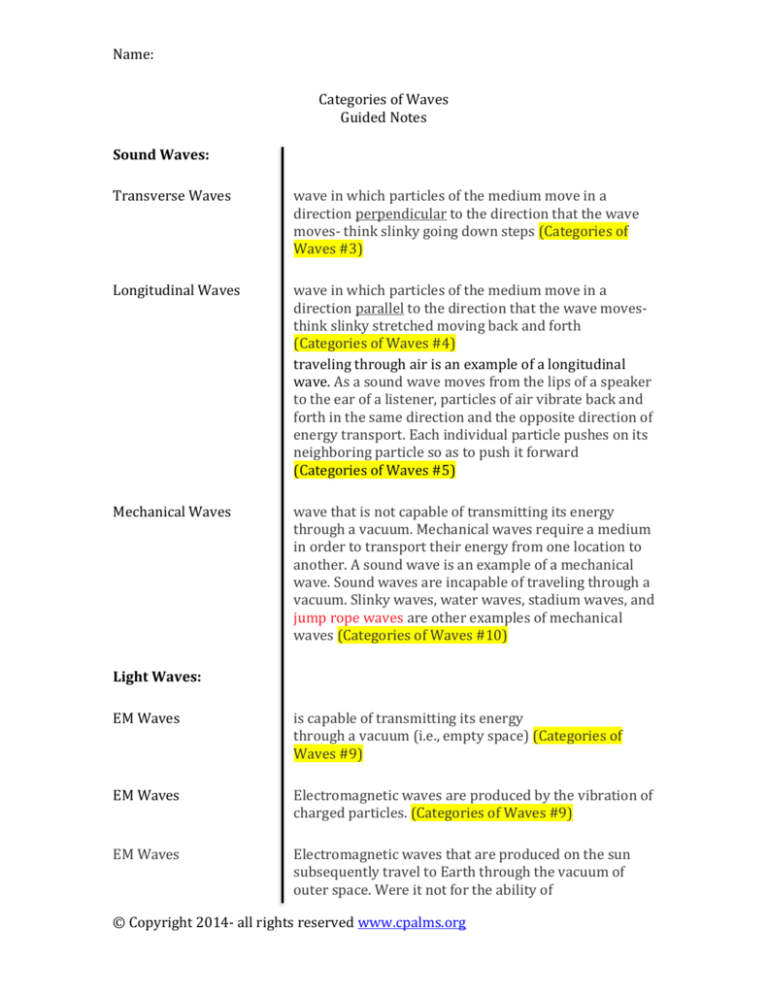
Name:
Categories of Waves
Guided Notes
Sound Waves:
Transverse Waves
wave in which particles of the medium move in a
direction perpendicular to the direction that the wave
moves- think slinky going down steps (Categories of
Waves #3)
Longitudinal Waves
wave in which particles of the medium move in a
direction parallel to the direction that the wave movesthink slinky stretched moving back and forth
(Categories of Waves #4)
traveling through air is an example of a longitudinal
wave. As a sound wave moves from the lips of a speaker
to the ear of a listener, particles of air vibrate back and
forth in the same direction and the opposite direction of
energy transport. Each individual particle pushes on its
neighboring particle so as to push it forward
(Categories of Waves #5)
Mechanical Waves
wave that is not capable of transmitting its energy
through a vacuum. Mechanical waves require a medium
in order to transport their energy from one location to
another. A sound wave is an example of a mechanical
wave. Sound waves are incapable of traveling through a
vacuum. Slinky waves, water waves, stadium waves, and
jump rope waves are other examples of mechanical
waves (Categories of Waves #10)
Light Waves:
EM Waves
is capable of transmitting its energy
through a vacuum (i.e., empty space) (Categories of
Waves #9)
EM Waves
Electromagnetic waves are produced by the vibration of
charged particles. (Categories of Waves #9)
EM Waves
Electromagnetic waves that are produced on the sun
subsequently travel to Earth through the vacuum of
outer space. Were it not for the ability of
© Copyright 2014- all rights reserved www.cpalms.org
Name:
electromagnetic waves to travel to through a
vacuum,there would undoubtedly be no life on Earth.
(Categories of Waves #9)
EM Waves
All light waves are examples of electromagnetic waves.
(Categories of Waves #9)
Summary:
When reading the Categories of waves article, I found that transverse waves move
perpendicular to the particles ( up and down) and longitudinal waves move parallel
to the particles (back and forth). Both transverse and longitudinal waves are
classified as Mechanical waves. Mechanical waves require a medium to travel
through. An example of mechanical waves is sound waves. Electromagnetic waves
are capable of transmitting energy in a vacuum, in other words, require no medium
to travel through. EM waves are produced by the sun and travel through space to
Earth. All forms of light (light waves) are considered EM waves. Based on my
Explore observations I found that EM waves travel fastest through gases, then
liquids and slowest through solids. Mechanical waves are just the opposite, they
travel fastest through solids, because of the particles assisting in creating vibrations,
then liquids and slowest through gases, due to lack of particles to create vibrations.
overall both are waves that can transfer energy, but Mechanical waves require a
medium and have different types of movements.
© Copyright 2014- all rights reserved www.cpalms.org









